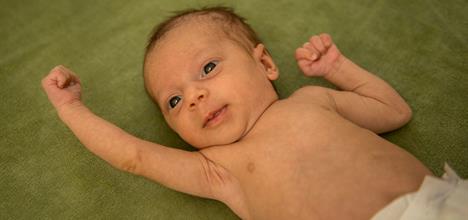Many of your baby's movements in their first weeks are done by reflex. This means it is involuntary or happens without your baby trying. If you put your finger in their mouth, they suck reflexively. They shut their eyes tightly to a bright light.

Some reflexes remain with newborns for months, while others go away in weeks. Here are some you can watch for in your baby:
Rooting
In some cases, reflexes change into voluntary behavior. For example, your baby is born with a rooting reflex that prompts him to turn his head toward your hand if you stroke his cheek or mouth. This helps him find the nipple at feeding time. At first, he'll root from side to side, turning his head toward the nipple and then away in decreasing arcs. He'll simply move his head and mouth into position to suck.
Sucking
Sucking is another survival reflex present even before birth. In fact, if you had an ultrasound during pregnancy, you may have seen your baby sucking their thumb.
After birth, when a nipple and areola are placed deeply in your baby's mouth, he automatically begins to suck. This motion actually has two stages. First, he places his lips around the areola with the nipple far back in the mouth, pointed to the junction of the hard and soft palate, and compresses the breast between his tongue and palate (called "expression," this action forces the milk out). In the second phase, or milking action, the tongue moves from the areola to the nipple. This whole process is helped by the suction that secures the breast to the baby's mouth.
Coordinating these rhythmic sucking movements with breathing and swallowing is a relatively complicated task for a newborn. So even though this is a reflexive action, not all babies suck efficiently at first. With practice, however, the reflex becomes a skill that they all manage well.
Rooting, sucking, and bringing his hand to his mouth are considered feeding cues in the first weeks after birth. Later on, after breastfeeding is well established, your baby will start to use these movements to console himself, and may also be comforted by a pacifier or when you help him find his thumb or fingers.
Newborn Reflexes
The following are some normal inborn reflexes you will see during the first weeks. Not all infants acquire and lose these reflexes at exactly the same time, but this table will give you a general idea of what to expect.
| Reflex | Age When Reflex Appears | Age When Reflex Disappears |
| Stepping | Birth | 2 months |
| Rooting | Birth | 4 months |
| Palmar grasp | Birth | 5-6 months |
| Moro reflex | Birth | 2 months |
| Tonic neck reflex | Birth | 5-7 months |
| Plantar grasp | Birth | 9-12 months |
Moro or "startle" reflex
A dramatic reflex during these first few weeks is the Moro reflex. If your baby's head shifts position abruptly or falls backward--or if he is startled by something loud or abrupt--he will extend his arms and legs and neck and then rapidly bring his arms together. He may even cry loudly. The Moro reflex, which is present in varying degrees in different babies, usually peaks during the first month and starts to disappear after about two months.
Tonic neck reflex or "fencing" posture
A more interesting automatic response is the tonic neck reflex, or the fencing posture. You may notice that when your baby's head turns to one side, his corresponding arm will straighten, with the opposite arm bent, as if he's fencing. You may not see this response, however, since it is subtle, and if your baby is disturbed or crying, he may not perform it. It disappears at five to seven months of age.
Both the Moro and tonic neck reflexes should be present equally on both sides of the body. If you note that the reflex seems different on one side, or that the baby moves one side of the body better than the other, tell your pediatrician.
Grasping
You'll see still another reflex when you stroke your baby's palm and watch him immediately grip your finger. Or, if you stroke the sole of his foot, you can watch his toes curl tightly. In the first few days after birth, your baby's grasp will be so strong it may seem he can hold his own weight—but don't try it. He has no control over this response and may let go suddenly.
Stepping
Aside from strength, your baby's other special talent is stepping. He can't support his weight, of course, but if you hold him under the arms (being careful to support his head as well) and let his soles touch a flat surface, he'll place one foot in front of the other and "walk."
This reflex will help a newborn crawl to the breast right after delivery when lying on their mother's abdomen. This reflex will disappear after two months, then show up again toward the end of the first year as the learned behavior of walking.
Last Updated 3/8/2022
Source Adapted from Caring for Your Baby and Young Child: Birth to Age 5 7th Edition (Copyright © 2019 American Academy of Pediatrics)
Article excerpted from healthychildren.org, copyright of the original author.
